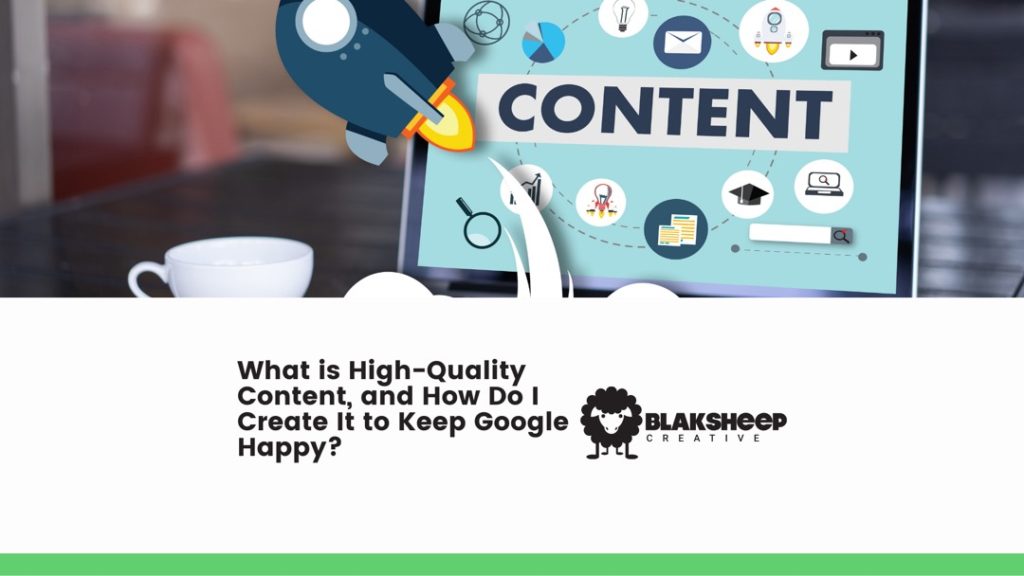Is your content up to scratch? The SEO and reputation of a website are primarily determined by its quality, so it’s essential not only for business owners but also for customers who want high-quality information across the board.
Find out what “high-quality” means in this article as we explore how you can ensure that all posts meet these standards and improve search engine rankings.
What is High-Quality Content?
In short, high-quality content achieves its marketing goals. It’s also:
- helpful to people
- engaging (and entertains where relevant)
- educational
- accurate
- relevant to your business and industry – though also speaks to the needs of individual customers
- reader-focused, rather than promotional or “salesy” in tone
- the best answer for the searcher’s query
Suppose that your primary focus is on increasing the number of social shares on Facebook. If your content meets this goal, it is “high-quality.”
But for another business whose main objective is generating more leads, the same content might not be considered high quality.
That’s because it doesn’t help the business achieve its marketing goals.
Does that mean that it’s low-quality content? It depends on who you ask.
Some of the ways to determine if your content is good are by looking at some KPIs, or Key Performance Indicators, such as:
- Ranking in the top three of Google for your target keyword(s).
- Increasing brand awareness and customer loyalty.
- Generating new leads and sales.
- Improving click-through rates and lowering bounce rates.
- Getting more traffic through a strong overall presence in organic search results.
- Getting social shares and website visits from social media marketing campaigns.
- Improving on-site conversions and revenue.
- Attracting relevant links from authoritative domains.
If your content is helping you achieve these top KPI goals, you’re on the right track with your content strategy.
Learn more about KPIs and which ones you should worry about (and those you shouldn’t)
What is Low-Quality Content?
Content that does not meet your marketing and branding aims is considered low-quality. Some types of low-quality content include:
Duplicate content
This includes copying and pasting text from other sources without adding value to the end user’s experience.
Spun content
This is “rewritten” with different words and phrases but is still basically the same as the original.
Automatically generated content
This includes automatically generated meta titles and descriptions that are not written by a human or naturally occurring.
Thin content
These are pages with insufficient information to be of no real value to the end-user – typically pages primarily created to rank for a particular keyword.
Keyword stuffing
This includes adding one or more keywords frequently with no added value to the content.
Link schemes
This is when you create links for the sole purpose of influencing search engine rankings.
Cloaking
Creating two separate versions of your site, one for users and another for search engines.
Avoid tricks intended to manipulate search engines. You may get away with it for a while, but Google (and the other search engines) are constantly improving their algorithms to detect manipulative strategies like these.
In other words, you can get lots of traffic for a short amount of time, but eventually, you’ll see your site’s rankings drop, and it will become harder to break into Google’s top results.
How To Keep Google Happy: Make Quality Content
So, how do you create high-quality content? Here are some tips:
Top 13 Ways to Creating Quality Content
Once you have set up your strategy and have established ways to measure its success, it’s time to start producing some engaging content.
1. Know Your Search Intent and Call to Action
Search intent is the user’s goal in typing a search phrase into the search engines, i.e., what do they intend to do once they find your content?
Exactly what action do you want them to take? Make sure that each piece of content you produce is relevant to their intent and clearly calls your readers/viewers to take the next step.

It includes the following categories:
- Transactional queries are looking for what product or service is available and where they can find it.
- Information queries are looking for unbiased, factual information about a subject.
- Navigational searches intend to visit a particular website, like when you type in your own website URL.
The first step in creating your content strategy is understanding what you want out of the experience.
Are you trying to sell a product or service?
Build an email subscriber list for future marketing campaigns?
All aspects of great content must work together and align to fulfill their desired call-to-action (CTA).
Figure out your audience’s search intent and create content specifically for them. Learn more about searcher intent in our recent blog post.
Use Quality Keywords & Topics
Before you begin writing your article, blog post, or webpage, do some keyword research to find industry-related keywords currently being searched by your audience.
The stronger the topic relevance and search volume of the keywords you choose, the more likely people will want to read what you have to say. And don’t get too focused on high volume/low competition keywords, as they won’t always bring conversions.
Quality keywords also help your content stand out in Google’s top results.
Write Headlines That Make an Impact
The headline is the most critical part of your content quality because it’s what entices people to click through to read more.

Make sure your headlines are short, attention-grabbing, and descriptive enough that people understand what they’ll find when they click on the link.
A strong headline can make your content more shareable, which increases your site’s exposure to search engines, leading to higher rankings.
Use Proper Formatting for Readability and Enjoyability
When writing an email, blog post, or creating content for social media, it’s essential to use proper formatting.

This includes the following:
- Proper headings and subheadings that break up long pieces of text into easily digestible sections.
- Short paragraphs with plenty of white space, so the reader doesn’t feel overwhelmed.
- Bulleted lists when appropriate to make the information easy to follow and skim.
- Enough graphics or photos to break up large chunks of text.
- Keeping your formatting consistent throughout each piece of content will improve readability for your end-users, which will also help search engines understand what your page is about!
You want your content to be easily read for consumers and search engines as they crawl and index it.
The way you format plays a significant role in its overall performance; people will only respond well with short blocks of text broken up by white space (headings/sub-headings).
Google does not like giant blocks either, so make sure there are enough breaks throughout!
This may sound elementary, but be sure to format your content in a logical order that your target audience will find logical, too.
Don’t just list random keywords or phrases in a given order to get more mileage out of the content – it needs to have real value for your users!
Find Trending Topics and Create a Content Idea Backlog
Effective content marketing strategy comes down to the topics you choose.
Why not give your audience what they’re looking for?
Make sure that your target audience will be interested in what you have for them, or they might just scroll past!
Check out competitors’ high-performing content and trending topics with tools like BuzzSumo or ExplodingTopic. As you find topics that fit your goals, plug them into your editorial calendar and create a backlog of content ideas.
Get a free content calendar template on our recent blog post.
Do Your Homework to Maintain Trust and Authority
Whatever your topic is, you must research it. This is critical for both humans and search engines.
You cannot write about any topic you want without doing the necessary research to back up what you say!

Whether you are writing an instructional guide, sales page, or blog post, make sure sources are cited throughout the document.
Google Scholar is an excellent tool that you can use when researching your content.
Google is looking for trustworthy websites, so be sure to include references so your readers can see how credible you are.
Have your content reviewed by others before publishing it on the web; both humans and crawlers alike will appreciate the extra effort!
Why Trust Matters
In a world where trust in institutions and media is at an all-time low, it’s more important than ever to make sure readers can trust your content.
This means doing thorough research on the subject of your article before you start writing so that any information or claims presented as fact will stand up well against outside scrutiny.
Citing current studies and data when possible helps keep things fresh for readers, too – they’ll know what kind of updates (if any) are relevant right away rather than having them dig through old news archives later like many people do these days!
One way I’ve found success using Google Alerts was by setting one up myself for “machine learning,” which alerted me if anything related appeared online: articles mentioning phrases such as “machine learning languages,” A.I., machine learning news stories, and other relevant keywords that people could be searching to find this kind of information.

You can even plug in your brand’s name directly to watch for mentions of it online. You will get notifications of any posts that mention your company, even if they aren’t linking back to you!
This is an excellent way of staying on top of things, catching up with the latest news in your industry, whether it relates to you or not, and seeing what’s upcoming without having to spend hours combing the web for it.
Add Your Own Perspective to Make Your Topics Unique
Every topic has been covered a million times, but if you have a unique perspective to add to it, people will want to read what you have to say!
This is something I constantly keep in mind when writing blog posts myself – even though the topic may not be new, I try and frame things from my own perspective so that whoever’s reading it will get a fresher, more exciting take on the subject.
Include your own voice and personal experiences to help things stand out from the pack!
You’ll do well to avoid writing in a stiff or formal tone, too – most people won’t want to read long-winded articles that don’t come across as conversational.
People don’t want to read generic postings about topics that everyone else has written on. Many web admins and content marketers fall into this trap when they share what’s popular or trending, only with less success than the pros!
If you wanted to create quality content around “game of thrones,” for example, you would be better off focusing on a unique topic like “learning more about the costumes of Game of Thrones” or “best places to visit on vacation; inspired by Game of Thrones .”
There are so many different ways you can take a subject and make it your own – it’s just a matter of thinking outside the box!
Capitalize on your Own Expertise, Research, and Data
Building up your own data and capitalizing on content that talks about your brand are huge or SEO.
I mean, who doesn’t want to get credit where it’s due?
Think not just about your own material but also about whatever others have written concerning you and your brand.
You can take the content that’s already out there and rework it in a way that will make people want to read/share it again – maybe with a fresh perspective or additional information they may have overlooked?
Once your data is out there, there’s a much better chance that other websites will link to It, too.
These backlinks from credible sites will help improve your site’s authority and credibility and give your SEO an enormous boost, especially if any of these sources are well-known sites such as CNN or Forbes.
In today’s world, everyone needs to be their own P.R. agent – you never know who might want a piece of content you’ve written and exactly how they’ll use it.
It’s always better to have more eyes on your work than just your own!
Stay Focused on Your Topic, but Don’t Be Afraid to Niche Down.
Even though you may have a broad range of topics that you’d like to write about, don’t try and tackle them all at once!
Instead, choose one topic and go deep on it.
Whether a piece of content turns into a five-page article or a series of blog posts, each entry should be related to your topic.
This is especially important in the blogging world, where people are likely to link back to your posts when they share them!
Focusing on one particular topic will make it easier for you to build up authority and trust with Google.
After all, they want their search results pages to be full of helpful info. It’s far less valuable for Google if your website is full of different pieces on different topics, all written by one or two people!
At the same time, you don’t want to get too narrow. Being an expert in one field means nothing-it’s what you can bring to your topic that counts.
Plus, by narrowing (or niching down) your topic, you’ll likely be ranking for long-tail keywords – those specific search queries that are less competitive.
Remember, if you want to stay ahead of the game, it’s always better to choose a ‘less crowded’ area of interest than try and compete with the big guys.
Mix It Up for Your Users and Search Engines with Multimedia Content

Visual information is simpler to comprehend and recall than textual content. Visual assets that work best with written materials include:
- Screenshots.
- Photos.
- Infographics.
- Charts.
- Video Content
- Gifs.
- Memes.
Multimedia may be used to enhance your written content in various ways and is frequently an effective strategy to illustrate a point or give an example.
Plus, search engines see these types of rich media as valuable, which can help improve your website’s ranking.
Multimedia content is an enormous tool that you can use to produce high-quality content!
Review and Edit Before Publishing
A high-quality reputation is essential for any business owner.
If you are in the business of writing, publishing first drafts without so much as a quick proofread shouldn’t even be on your radar!
Spelling mistakes and grammar errors can be a real turn-off, especially if you have an otherwise excellent piece of content.
There’s no excuse for publishing something full of errors or sloppy writing! Unfortunately, most marketers don’t have a grasp on this.
If a sentence doesn’t make complete sense, consider revising it so that it does.
It might even be better to scrap it entirely and start from scratch rather than let something subpar go out into the world.
Your readers are counting on you!
A great way to maintain this status and avoid being found wanting when it comes to deadlines is to plan ahead.
Use an editorial calendar that will help keep track of what needs doing when and how much time each task should take. This will give you enough room before moving onto something new while still ensuring everything gets done correctly and according to your timeline.
Use Analytical Data to Measure Content Performance and Adjust Your Strategy
Proof of your content’s success is going to be in the numbers.
Use these top KPIs that we discussed at the beginning of this article, and see which topics are performing well with little or no traffic so you can focus on those areas moving forward for better results!
Need Help Generating High-Quality Content?
If you’re not a ‘natural writer, the idea of having to produce and publish high-quality content can be daunting.
Luckily for you, that’s why there are professional content marketers like us!
We create high-quality content and blog posts to maximize your search engine rankings and build brand authority, so it’s no wonder why we’ve worked with some of the biggest names in Louisiana.
Without a solid strategy, we’d just be guessing what we needed to do instead of following an optimization plan that’s proven time and again to work.
Get in touch with us today to talk to one of our digital marketing experts and discover how we can help you use content marketing to connect with your customers.
You won’t be sorry!
















































